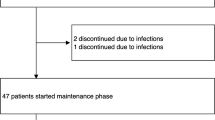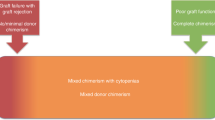Summary:
Autoimmune haemolytic anaemia (AIHA), immune thrombocytopenia (ITP) and autoimmune neutropenia (AIN) are well-recognised complications of allogeneic stem cell transplantation (SCT), but have previously only been reported in the context of myeloablative conditioning regimens. Management of AIHA, ITP or AIN occurring after allogeneic SCT is unsatisfactory since they frequently prove refractory to conventional therapies including splenectomy. As a consequence, autoimmune cytopenias occurring after allogeneic SCT are associated with substantial morbidity and mortality. We report four patients who developed AIHA or ITP after allogeneic transplantation – three of which occurred after a reduced-intensity conditioning (RIC) regimen. All patients demonstrated a complete response to Rituximab, having failed to respond to conventional treatment including high-dose prednisolone and intravenous immunoglobulin (IVIg). We conclude that Rituximab can be a valuable agent in the management of autoimmune cytopenias occurring after allogeneic SCT and that autoimmune cytopenias may be a hitherto unrecognised complication of RIC regimens.
This is a preview of subscription content, access via your institution
Access options
Subscribe to this journal
Receive 12 print issues and online access
$259.00 per year
only $21.58 per issue
Buy this article
- Purchase on Springer Link
- Instant access to full article PDF
Prices may be subject to local taxes which are calculated during checkout
Similar content being viewed by others
References
Horn B, Viele M, Mentzer W et al. Autoimmune hemolytic anemia in patients with SCID after T-cell depleted BM and PBSC transplantation. Bone Marrow Transplant 1999; 24: 1009–1013.
Herbert H, Einsele H, Klien R et al. CMV infection after allogeneic transplantation is associated with the occurrence of various autoantibodies and monoclonal gammopathies. Br J Haematol 1996; 95: 138–144.
Drobyski WR, Potluri J, Sauer D et al. Autoimmune hemolytic anemia following T-cell depleted allogeneic bone marrow transplantation. Bone Marrow Transplant 1996; 17: 1093–1099.
Cwynarski K, Goulding R, Pocock C et al. Immune hemolytic anemia following T-cell depleted allogeneic bone marrow transplantation for chronic myeloid leukaemia: association with leukaemic relapse and treatment with donor lymphocyte infusions. Bone Marrow Transplant 2001; 28: 581–586.
Klumpp TR, Herman JH, Schnell M et al. Association between antibodies reactive with neutrophils, rate of neutrophil engraftment, and incidence of post-engraftment neutropenia following BMT. Bone Marrow Transplant 1996; 18: 559–564.
Kottaridis PD, Milligan DW, Chopra R et al. In vivo CAMPATH-1H prevents graft-versus-host disease following nonmyeloablative stem cell transplantation. Blood 2000; 96: 2419–2425.
Chakraverty R, Peggs K, Chopra R et al. Limiting transplantation-related mortality following unrelated donor stem cell transplantation by using a nonmyeloablative conditioning regimen. Blood 2002; 99: 1071–1078.
Maris MB, Niederwieser D, Sandmeier BM et al. HLA-matched unrelated donor hematopoietic cell transplantation after nonmyeloablative conditioning for patients with hematologic malignancies. Blood 2003; 102: 2021–2030.
Faulkner RD, Craddock C, Byrne JL et al. BEAM-alemtuzumab reduced-intensity allogeneic stem cell transplantation for lymphoproliferative diseases: GVHD, toxicity and survival in 65 patients. Blood 2004; 103: 428–434.
Delgrado J, Bustos JG, Jimenez-Yuste V et al. Anti- CD20 monoclonal antibody in refractory immune thrombocytopenic purpura. Haematologica 2002; 87: 215–216.
Zaja F, Iaocona I, Masolini P et al. B-cell depletion with Rituximab as treatment for immune hemolytic anemia and chronic thrombocytopenia. Haematologica 2002; 87: 189–195.
Stasi R, Pagano A, Stipa E et al. Rituximab chimeric CD20 antibody treatment for adults with chronic idiopathic thrombocytopenic purpura. Blood 2001; 98: 952–957.
Ratanatharathorn V, Carson E, Reynolds C et al. Anti-CD20 chimeric monoclonal antibody treatment of refractory immune-mediated thrombocytopenia in a patient with chronic graft-versus-host disease. Ann Int Med 2000; 133: 275–279.
Hongeng S, Tardong P, Worapongpaiboon S . Successful treatment of refractory autoimmune hemolytic anaemia in a post-unrelated bone marrow transplant paediatric patient with Rituximab. Bone Marrow Transplant 2002; 29: 871–872.
Corti P, Bonanomi S, Vallinoto C et al. Rituximab for immune hemolytic anaemia following T and B cell depleted hematopoietic stem cell transplantation. Acta Haematol 2003; 109: 43–45.
Author information
Authors and Affiliations
Corresponding author
Rights and permissions
About this article
Cite this article
Raj, K., Narayanan, S., Augustson, B. et al. Rituximab is effective in the management of refractory autoimmune cytopenias occurring after allogeneic stem cell transplantation. Bone Marrow Transplant 35, 299–301 (2005). https://doi.org/10.1038/sj.bmt.1704705
Received:
Accepted:
Published:
Issue Date:
DOI: https://doi.org/10.1038/sj.bmt.1704705
Keywords
This article is cited by
-
Autoimmune cytopenias (AIC) following allogeneic haematopoietic stem cell transplant for acquired aplastic anaemia: a joint study of the Autoimmune Diseases and Severe Aplastic Anaemia Working Parties (ADWP/SAAWP) of the European Society for Blood and Marrow Transplantation (EBMT)
Bone Marrow Transplantation (2020)
-
Dramatic response to rituximab in a child with severe cold autoimmune hemolytic anemia arising after allogeneic hematopoietic SCT
Bone Marrow Transplantation (2010)
-
Diagnosis and treatment of autoimmune haemolytic anaemias in adults: a clinical review
Wiener klinische Wochenschrift (2008)
-
Rituximab therapy for chonic and refractory immune thrombocytopenic purpura: a long-term follow-up analysis
Annals of Hematology (2007)
-
Low rate of long-lasting remissions after successful treatment of immune thrombocytopenic purpura with rituximab
Annals of Hematology (2007)



